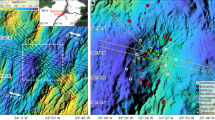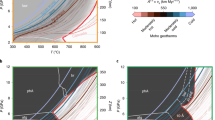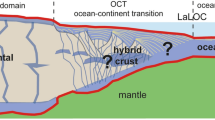Abstract
In the hydrothermal circulation at mid-ocean ridges, sea water penetrates the fractured crust, becomes heated by its proximity to the hot magma, and returns to the sea floor as hot fluids enriched in various chemical elements. In contradiction to earlier results1 that predict diminishing hydrothermal activity with decreasing spreading rate, a survey of the ultra-slowly spreading Gakkel Ridge (Arctic Ocean) by Edmonds et al.2 and Michael et al.3 suggests that, instead of being rare, the hydrothermal activity is abundant — exceeding by at least a factor of two to three3 what would be expected by extrapolation from observation on faster spreading ridges. Here we use helium-3 (3He), a hydrothermal tracer4, to show that this abundance of venting sites does not translate, as would be expected, into an anomalous hydrothermal 3He output from the ridge. Because of the wide implications of the submarine hydrothermal processes for mantle heat and mass fluxes to the ocean, these conflicting results call for clarification of the link between hydrothermal activity and crustal production at mid-ocean ridges.
Similar content being viewed by others
Main
On the basis of the axial distribution of light scattering and manganese tracer anomalies measured during the Arctic mid-ocean ridge experiment (AMORE), hydrothermal activity on Gakkel Ridge has been reported to be “far more abundant than predicted on the basis of previous correlations with spreading rate”3. Owing to the high enrichment of the hydrothermal fluids in mantle 3He (typically a factor of 104 relative to ambient sea water), this abundant hydrothermal activity should logically correspond to an enhanced 3He output from the ridge.
At a global scale, three-dimensional oceanic general circulation models make a good job of simulating the oceanic distribution of hydrothermal 3He by using the simple assumption that the 3He source intensity is linearly correlated with the spreading rate5,6. The slope of the 3He flux–spreading rate relationship is close to 330 3He mol km−2 of crustal spreading, translating into a world average 3He annual flux of 0.33 mmol km−2 of ridge and per mm yr−1 of full spreading rate. Available 3He fluxes determined for active portions of ridge show results consistent with this global trend (Fig.1a).
a,3He annual flux per kilometre of ridge as a function of spreading rate. The linear relationship used in GCM simulations5,6 is shown (dashed line). The Mid-Atlantic Ridge (MAR) Lucky Strike site and Red Sea values are from refs 910. The Rainbow site (MAR) value is unpublished data. b, Eurasian basin box model : Eurasian basin deep and bottom waters (EBDW and EBBW respectively) are directly ventilated by the sinking of dense shelf waters from the Barents Sea. They leave the basin through the western part of the Fram Strait and mix with the Greenland Sea and Norwegian Sea deep waters (NSDW). In addition to the Barents Sea waters, some NSDW also return to the north and re-enter the deep Arctic through the eastern part of the Fram strait7. 39Ar values7 are expressed as a percentage of modern concentration. 3He data are expressed using the isotope δ notation.
Gakkel Ridge stretches 1,800 km across the Eurasian basin of the Arctic Ocean. Residence time of deep and bottom waters in the Greenland/Norwegian seas and the Eurasian basin have been studied in detail in the recent past using multi-tracer balances7. 3He concentrations are relatively low in the deep waters of the Arctic Ocean: Eurasian basin deep waters (EBDW), which are at 1,500–2,600 m depth, show a 3He excess relative to solubility equilibrium of 4.3±0.8%, whereas the Eurasian basin bottom waters (EBBW) average 3He excess is 3.7±0.6% (refs 7, 8).
The 3He input from Gakkel Ridge to the EBBW and EBDW can be calculated using a simplified version of a box model7 (Fig.1b). Water fluxes are derived from the 39Ar radioactive tracer budget (39Ar is a cosmogenic isotope with a half-life of 269 years), allowing the mantle 3He flux to be calculated from the 3He budget. Taking into account the uncertainties in the data, a maximum 3He input of 3.4 mol yr−1 is inferred. Scaled to the length and spreading rate of Gakkel Ridge, the mantle 3He input translates into an annual flux of 0.15–0.32 mmol km−1 of ridge and per mm yr−1 of full spreading rate (Fig.1a), showing no positive anomaly with respect to that expected from the value of the spreading rate.
One explanation mentioned by Michael et al.3 for the observed discrepancy could be that the high plume incidence observed during the survey (80% plume incidence on the 145 profiles) overestimated the abundance of vents because of the confined nature of the deep unsegmented rift valley. It is possible that plume meanders originating from a single vent site may have been interpreted as corresponding to different sources. Alternatively, if the inferred number of vent sites is right, an explanation may rest on the fact that vent frequency is not a direct measurement of hydrothermal activity.
It is also possible that, on ultra-slowly spreading ridges, individual plumes carry fewer chemicals and less heat, so higher frequency does not necessarily mean higher hydrothermal activity. The apparent discrepancy between the enhancement factor of two to three in the vent site frequency deduced from along axis tracer surveys and the low 3He flux may therefore primarily reflect the unusual characteristics of the hydrothermal circulation on this ultra-slowly spreading ridge.
Detailed investigation of individual venting sites in such environments is needed to resolve this issue and to reassess the geological parameters that control ridge processes, including hydrothermal plume and vent frequency, fluid circulation and fluxes.
References
Baker, E.T., Chen, Y. J. & Phipps Morgan, J. Earth Planet. Sci. Lett. 142, 137–145 (1996).
Edmonds, H. N. et al. Nature 421, 252–256 (2003).
Michael, P. J. et al. Nature 423, 956–961 (2003).
Craig, H. & Lupton, J. E. in The Sea Vol. 7, 391–428 (Wiley, New York, 1981).
Farley, K. A., Maier-Reimer, E., Schlosser, P. & Broecker, W. S. J. Geophys. Res. 100, 3829–3839 (1995).
Dutay, J.C. et al. J. Mar. Syst. (in the press).
Boenisch, G. & Schlosser, P. Prog. Oceanogr. 35, 29–52 (1995).
Schlosser, P. et al. Prog. Oceanogr. 35, 1–28 (1995).
Jean-Baptiste, P. et al. Earth Planet. Sci. Lett. 157, 69–77 (1998).
Jean-Baptiste, P., Fourré, E., Metzl, N., Ternon, J. F. & Poisson, A. J. Mar. Syst. (in the press).
Author information
Authors and Affiliations
Corresponding author
Rights and permissions
About this article
Cite this article
Jean-Baptiste, P., Fourré, E. Hydrothermal activity on Gakkel Ridge. Nature 428, 36 (2004). https://doi.org/10.1038/428036a
Issue Date:
DOI: https://doi.org/10.1038/428036a
Comments
By submitting a comment you agree to abide by our Terms and Community Guidelines. If you find something abusive or that does not comply with our terms or guidelines please flag it as inappropriate.




